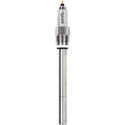
What are Ions?
Ions are divided into two groups; cations and anions. Cations have a positive charge and include sodium (Na+), calcium (Ca++), and magnesium (Mg++). Anions have a negative charge and include chloride (Cl-), sulfates (SO4--), and bicarbonates (HCO3-).
How are ions removed from water?
Ions are removed from water through a series of chemical reactions. These reactions take place as the water passes through ion exchange resin beds. Cation resin contains hydrogen (H+) ions on its surface which are exchanged for positively charged ions. Anion resin contains hydroxide (OH-) ions on its surface which are exchanged for negatively charged ions. The final product of these two exchanges, H+ and OH-, form water molecules.
Separate bed reaction
When cation and anion resins are separated, reactions take place independently and are incomplete, thus only moderate ion exchange is achieved.
Mixed bed reaction
When cation and anion resins are mixed, reactions take place to their completion simultaneously exchanging both cations and anions, providing water that is virtually ion free.
How are ions measured?
Electrical conductance or resistance is measured by two in-line electrodes. Electrical current moves through water using ionic molecules as stepping stones. The fewer stepping stones, the more difficult the passage of electricity. This causes less electrical conductance and more electrical resistance. The temperature of the water also affects its conductivity/resistivity. Thornton electrodes and meters automatically compensate for water temperature to ensure accuracy.
Osmosis
To understand reverse osmosis we must first understand osmosis. During natural osmosis, water flows from a less concentrated solution through a semipermeable membrane to a more concentrated saline solution until concentrations on both sides of the membrane are equal (see figure 2).

Reverse osmosis requires external pressure to reverse natural osmotic flow. As pressure is applied to the saline solution, water flows through the semipermeable membrane (see figure 3).
Reverse Osmosis Membrane
A reverse osmosis membrane has a thin microporous surface that rejects impurities, but allows water to pass through. The membrane rejects bacteria, pyrogens, and 85%-95% of inorganic solids. Polyvalent ions are rejected easier than monovalent ions. Organic solids with a molecular weight greater than 300 are rejected by the membrane, but dissolved gases pass through. Reverse osmosis is a percent rejection technology. The purity of the product water depends on the purity of the inlet water. The purity of reverse osmosis product water is much higher than the purity of the feedwater (see figure 4).

A large percentage (50-90%) of the feedwater does not pass through the membrane but flows across the membrane surface, constantly cleaning it and carrying the inorganic and organic solids to drain. This water is called "reject."
Feedwater Factors
Feedwater factors affecting membrane performance and life include the following:
- Pressure
Feedwater pressure affects both the quantity and the purity of reverse osmosis product water. Lower feedwater pressure causes lower product flow rate and lower product purity. - pH
Feedwater pH range is important. It is recommended that you use wider pH range membranes when feedwater is basic, acidic or unstable. - Langlier Saturation Index (LSI)
The LSI indicates the tendency for scale to form on a membrane surface. It requires feedwater testing for temperature, total inorganic solids, calcium hardness alkalinity, and pH. If the LSI index calculation is positive, it is recommended that you install a water softener prior to the reverse osmosis system. - Free Chlorine and Bacteria
Cellulose acetate membranes require constant free chlorine to prevent bacterial growth and membrane damage. In contrast, polyamide and thin film membranes are damaged by free chlorine. Activated carbon is used to remove free chlorine when polyamide and thin film membranes are chosen. - Temperature
Membrane performance is based on feedwater temperature of 25°C. For every 1°C below 25°C product water quantity is reduced by 3%. When feedwater temperature is regularly below 25°C, it is recommended that hot and cold water are mixed to increase the temperature to 25°C. Feedwater which is greater than 35° will damage most membranes. - Silt Density Index
The SDI is a measurement of submicron particles and their tendency to block membranes. Flowing water at specific pressure is filtered through a membrane disc and collected for a fixed period of time. The speed of water flow and total volume collected determines the index value. - Turbidity
Turbidity is a measurement of suspended submicron particles that obscure light rays.
Distillation differs from other forms of water purification because water is removed from the impurities rather than the impurities from the water. Water undergoes phase changes during the process, changing from liquid to vapor and back to liquid. It is the change from liquid to vapor that prompts a separation of water from its impurities. Impurities with a boiling point higher than water (100°C) remain in the boiler. Water and impurities with a boiling point equal to or lower than water are converted to water vapor. When this vapor is condensed, only water and a few substances that boil at lower temperatures than water remain.
How well does distillation work?
Distillation has the broadest capabilities of any single form of water purification. Distillation effectively removes most inorganic solids, all organics with a boiling point greater than water (100°), all bacteria and pyrogens. Gases and other organics are not removed by distillation. They undergo the same phase changes as the hydrogen and oxygen ions and can be removed before and after distillation using other technologies.



.png/_jcr_content/renditions/cq5dam.web.1280.1280.png)
